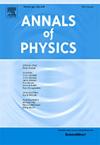协变双标量理论:具有协变G、c和自然筛选机制的模型
IF 3
3区 物理与天体物理
Q2 PHYSICS, MULTIDISCIPLINARY
引用次数: 0
摘要
本文考虑引力标量张量理论的双标量场扩展。我们的理论是基于度量张量gμν和两个标量场。我们保留了Brans-Dicke理论的想法,即引力耦合G是标量场φ动力学的有效现象。除此之外,我们把光速c提高到独立标量场的状态。在相空间中对系统的xμ和xμ进行了动力学分析,确定了稳定平衡点存在的条件。这些条件符合最近得到天体物理学和宇宙现象学支持的ansatz Ġ/G=3 * * /c的约束c3/G=常数。我们在FLRW宇宙学和我们称之为c-meleon的变色龙机制的背景下分析了这种可能性。我们得到了c-meleon场的具体解,包括(i) O 'Hanlon和Tupper-like解,(ii)尘埃加上变化的c(和G),以及(iii)真空能量加上变化的c(和G)。本文章由计算机程序翻译,如有差异,请以英文原文为准。
Covarying-Bi-Scalar Theory: A model with covarying G and c and a natural screening mechanism
In this paper we consider a double-scalar-field extension to scalar–tensor theories of gravity. Our theory is based in the metric tensor and two scalar fields. We keep the idea in Brans–Dicke theory that the gravitational coupling is an effective phenomenon from the dynamics of a scalar field . In addition to that, we raise the speed of light to the status of an independent scalar field. The dynamical analysis of and is performed in the phase space and the conditions for the existence of stable equilibrium points are determined. These conditions accommodate the constraint in accordance with the ansatz that has recently received support from astrophysical and cosmological phenomenology. We analyze this possibility in the context of FLRW cosmology and a chameleon-like mechanism we dubbed -meleon. We obtain specific solutions for the -meleon field, including (i) an O’Hanlon and Tupper-like solution, (ii) dust-matter plus the varying (and ), and (iii) vacuum energy plus the varying (and ).
求助全文
通过发布文献求助,成功后即可免费获取论文全文。
去求助
来源期刊

Annals of Physics
物理-物理:综合
CiteScore
5.30
自引率
3.30%
发文量
211
审稿时长
47 days
期刊介绍:
Annals of Physics presents original work in all areas of basic theoretic physics research. Ideas are developed and fully explored, and thorough treatment is given to first principles and ultimate applications. Annals of Physics emphasizes clarity and intelligibility in the articles it publishes, thus making them as accessible as possible. Readers familiar with recent developments in the field are provided with sufficient detail and background to follow the arguments and understand their significance.
The Editors of the journal cover all fields of theoretical physics. Articles published in the journal are typically longer than 20 pages.
 求助内容:
求助内容: 应助结果提醒方式:
应助结果提醒方式:


